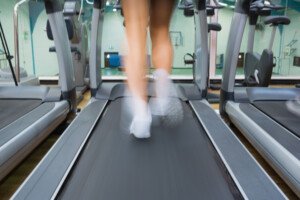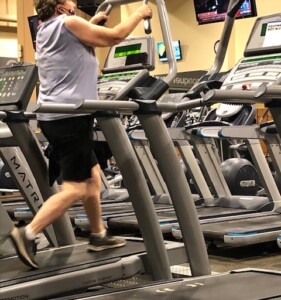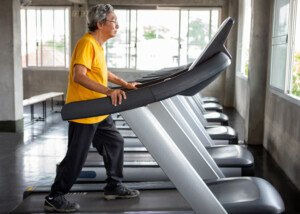
It’s cardiologist vs. personal trainer when it comes to how to properly use a treadmill and aerobic exercise in general.
Who wins?
I pointed out to a personal-training client that holding onto a treadmill was a bad habit that disrupted natural gait and did not simulate natural walking.
Her response? “Are you a cardiologist?” She then said her cardiologist told her to walk that way.
I’m not a cardiologist, but my knowledge of exercise science is sufficient for me to know that clutching the front bar of a treadmill also disrupts optimal breathing, can raise blood pressure and also lead to repetitive stress injuries in the hips, which are forced to over-rotate.
My mother years ago underwent multiple bypass surgery.
Her heart surgeon told her that the only exercise she ever needs is to just walk 40 minutes every day.
The patient pre-surgery was sedentary; did no exercise.
Post-surgery, she hears from her surgeon, “Walk 40 minutes a day. That’s all the heart needs.”
Because my mother frequently went shopping and lived in a big house at the time, and did all the housework, she convinced herself that this walking recommendation was automatically built into her day-to-day life!
Hence, she never committed to any 40 minute walking sessions.
The cardiothoracic surgeon’s exercise recommendation was too close to that of baseline living!
It’s one thing to suggest starting out with a 40 minute walk.
But to present this as the be-all, end-all, encourages patients to make no changes in their physical activity levels.
They may think, “I don’t have to go on 40 minute walks; I do plenty of walking every day on the job!”
At a minimum, not a maximum, you should get sustained aerobic exercise several times a week.
A treadmill is a good place to start.
How to Properly Use a Treadmill

Right! Shutterstock/gpointstudio
Unless you have a mobility impairment, there is no need to hold on — other than for momentary balance checks or steadiness while changing the settings, drinking a beverage, turning to greet someone and getting a heart rate.
A cardiologist may tell you to hold on to protect himself or herself from being blamed in case the patient falls off the treadmill and breaks an arm after being told by the cardioloist they should swing their arms.
But ask yourself this: How is the human body designed to walk?

Wrong!
How old were you when you began walking without clinging onto anything?
If you do not hold onto a treadmill, your body will be forced to balance all on its own, with no external help, and to assume correct posture.
Your balance will improve. You’ll burn more calories (the calorie display doesn’t change whether you’re holding on or not).
Holding onto a treadmill will train your body to use a walker. Do you want that?








































